Renault 400, 440, 480 Service Manual

NE 3/3914 AN
english edition
MAGNUM
E–TECH
400 – 440 – 480
50 21 014 670 – 11/03
édition anglaise
contents
Chapter
ALPHABETICAL INDEX . . . . . . . . . . . . . . . . . . . . . . A
SPECIFICATIONS . . . . . . . . . . . . . . . . . . . . . . . . . . . . B
USE OF THE VEHICLE . . . . . . . . . . . . . . . . . . . . . . . C
AIR CONDITIONING . . . . . . . . . . . . . . . . . . . . . . . . . D
CONSUMABLE PRODUCTS . . . . . . . . . . . . . . . . . . . E
SERVICING . . . . . . . . . . . . . . . . . . . . . . . . . . . . . . . . . . F
ELECTRICAL EQUIPMENT . . . . . . . . . . . . . . . . . . . G
SUPPLEMENT AT END OF HANDBOOK

WELCOME ON BOARD YOUR NEW RENAULT
You have now taken possession of your new vehicle.
We trust that it will give you the entire satisfaction you have the right to expect and which was the reason for your original choice.
This driving and servicing handbook has been compiled to provide all the information you need and will enable you to:
–Get to know your Renault better to derive maximum benefit from its advanced technical features in optimum working conditions.
–Permanently guarantee optimum operations by following the maintenance recommenda– tions.
–Cope with any minor problems not requiring assistance from a specialist, without losing too much time.
NOTE
This handbook covers all the options proposed to customers. Take into consideration only the indications regarding the model owned by you.
The few moments devoted to reading this handbook will be well worthwhile for the information it contains and by the new technical features you will discover. If any details remain unclear, our Dealer Staff will be pleased to provide you with any further information you may require.
HOW TO READ CROSS–REFERENCES
The reference numbers, figures and letters mentioned in the text refer back to two types of illustration:
–figures correspond to figures or photographs situated in proximity to the text
–letters, sometimes followed by a figure, correspond to the Instrument Panel diagram to be found inside the handbook.
“Bon voyage” at the wheel of your Renault !
RENAULT TRUCKS AND BUSES: FRONTIER–FREE SERVICE
Renault Service 24 has been in operation in Europe for several years now. 19 emergency call centres are listening in for you 365 days a year.
Spare parts officially approved by RENAULT TRUCKS meet both the requirements of the vehicle specification and the regulations in force. Only premium Renault parts will ensure:
–Original Equipment safety standards.
–Maintenance of original characteristics and performance.
–Full Manufacturer’s Warranty.
The manufacturer reserves the right to make any modifications deemed necessary during production. This handbook should not be considered as a specification for the model in question.
RENAULT V.I. – 2003 – Imprimé en France

GENERAL USAGE INSTRUCTIONS FOR COMMERCIAL VEHICLES
If you are a professional driver using your own vehicle, or a haulier entrusting one of your vehicles to a member of your staff, it is essential to follow and ensure the application of the following instructions. They are only a reminder of the basics of the trade and standard professional practice and in no way are to be taken as exhaustive. In this way you will obtain the maximum profit from your material and prevent any risk of accidents and incidents.
1.BASIC INSTRUCTIONS
–Every driver must possess all necessary licences and should only drive when physically fit and sufficiently rested.
–The vehicle must be in conformity with current legislation in the country or countries in which it is used.
–Any signs or panels indicating hazardous substances must be affixed and be in good condition.
–Loads:
. All–up or per–axle weights (regulatory or technical) must not be exceeded.
. Loading and securing of loads must be carried out using conventional procedures, tarpaulins and side curtains must be correctly stretched and fastened and doors and sideboards locked, etc.
–In the cab:
. Never carry dangerous products (such as petroleum, trichlorethylene, thinner, etc.).
. If an animal Is carried, it must be kept away from the driving position.
–Getting in and out of the vehicle:
. Use the steps and the handles provided. Never jump down from the vehicle.
. When leaving the vehicle, observe the traffic flow, particularly if you have been driving for a long time.
. Take extra care when the climatic conditions are bad (rain, snow, ice) and at night.
2.BEFORE GETTING INTO THE VEHICLE, CHECK
–General condition of your vehicle, visually (as per handbook).
–Tyre condition, tyre pressures (including the spare wheel), and that nothing is jammed between the twin wheels.
–Cleanliness of cab windows, rearview mirrors, headlights and other lights and number plates.
–Regulatory and optional lighting systems for correct operation.
–Semi–trailer and/or trailer for correct coupling (hook, brake hoses – colour coding – electrical connector...).
–For the presence and contents of the onboard tool kit.
–In winter, for the presence of anti–skid chains and that they are securely fastened.
–Vehicles equipped with side guard panels and beams should be permanently provided with this equipment. At the time of removal, make sure that the locks are correctly locked and tighten the setbolts moderately.

3.ONCE ONBOARD
–Check the condition of the non–slip pedal covers.
–Ensure that the safety controls. steering wheel, pedals, gear lever etc. are never cleaned with a slippery product like silicone.
–Adjust your driving position:
. Steering wheel: check that the steering column is locked.
. Seat: check that the seat is firmly locked.
. Rearview mirrors.
. If the vehicle is fitted with a seat belt, use it.
–Prior to starting the engine. ensure that the gear lever is in neutral.
–Check that all instrument panel indications are normal (if you are not certain of what the nominal readings are supposed to be, refer to the driving handbook) and that the tachograph disc is in place and that the unit is working properly.
4.WHEN DRIVING
–If you detect any anomaly in the way the vehicle is operating, stop and locate the mal– function.
Do not move off again until you are sure that the incident has not impaired technical performance and safety.
–When driving, the use of some of the standard–fitted equipment, and other optional or added equipment is strictly forbidden (CB, telephone, i.e. hand–operated sun–roofs, television sets, etc.) or only permitted if all necessary precautions are taken so as not to affect road safety (cigar lighter, manual selection of radio stations...).
–Adapt your driving style to suit your load (cant or bend, if the centre of gravity is high, etc.) to take account of weather conditions and the time of day.
If necessary, adjust the headlight beam levels.
–Never shut down the engine when the vehicle is moving (as this will cut off the supply to the power–assisted steering system and could decrease brake effectiveness).
5.WHEN PARKING
–Check that the vehicle is correctly parked (i.e. that it does not obstruct traffic flow or threaten the security of neighbouring installations).
–If the vehicle is going to remain stationary for some time, use one or more wheel chocks to Prevent it from moving (e.g. semi–trailer compressed air leakage, or in black ice conditions...).
–Check that:
. parking brake is locked and immobilizes the road train or rig,
. gear lever is in neutral,
. battery isolating switch is OFF,
. electromagnetic retarder is switched OFF,
. air vents are not blocked (i.e. if an independent heating system is used),
. parking lights are on at night.
–Check that you have not left in the cab:
. important documents (personal, vehicle, load),
. unaccompanied animals.

6. WHEN REPAIRING / SERVICING THE VEHICLE
IMPORTANT
Prior to carrying out any work on the electronic air suspension (other than calibration), place axle stands under the chassis.
–Check the tightness of the wheel nuts according to recommendations.
–Prior to tilting the cab:
. Check that there is enough space in front of the vehicle and take care that during this manipulation nobody tries to cross this area or park in it.
. Stop the engine, put the gear lever into neutral and make sure that no object is likely to fall onto the windscreen. If a refrigerator is fitted, drain it. Close the doors.
. Tilt the cab as far as possible. If the cab is only partially tilted, wedge it to prevent accidental movement.
–If the engine is running:
. Do not approach moving parts (fan, drive belts, etc.).
. Do not turn off the electrical power supply (shut down the engine first).
–When climbing up onto or down from the catwalk behind the cab (tractor), use the steps and grab handles provided. Never jump down from the catwalk. Take care not to burn yourself (on the vertical exhaust pipe and silencer).
–Fuel is inflammable, if the fuel filler cap is open, smoking is forbidden and there must be no naked flame in the vicinity.
–Batteries are filled with acids which can cause serious injuries. They must be handled with great care.
–If you start the engine using an external power source:
. Use cables of the correct dimensions.
. Make sure that the + and – polarities are connected properly.
–When changing a fuse, it is vital to use another fuse of the same size.
–Only specialists should install additional power lines.
–The installation of additional air lines requires a technical study to be carried out or approved by the manufacturer.
–It is strictly forbidden to heat polyamide hoses (braking circuit pipes).
–Raising the vehicle with a jack: chock the wheels prior to jacking.
–Immobilizing the vehicle: use one or several wheel chocks as necessary.
–Wheels and tyres:
. Never check tyre pressures or inflate or deflate a tyre which is hot.
. Never stand in front of a tyre when checking the pressure or inflating it.
. When fitting a roadwheel, take great care to centre wheels fitted with centring clamps (for trilex wheels, position the clamp at the segment crossover point).
–Repairs on the open road: collect all fluids which have been drained (such as oil, fuel, coolant...).
–With an eye to environmental protection, take into consideration the laws in force (recovery of oil / anti–freeze / cartridges).

–When draining oils (engine / gearbox / drive axles), you run the risk of burning yourself (hot oil).
–Independent heater, use vehicle diesel fuel only.
–If anti–skid chains are used, the rear wings should be removed, road speed should be reduced and chain tension should he tested at regular intervals.
Any modification to circuits (electrical, electronic or compressed air) may have serious consequences. Such work should only be undertaken in agreement with the manufacturer. RENAULT TRUCKS decline any responsibility in the event of non–conformity in assembly.
Only original RENAULT TRUCKS parts and circuits defined by the manufacturer guarantee quality, safety and reliability.
By observing the above instructions, you will be using your vehicle in the best possible way. However, you must also carefully read the driving handbook and consult the RENAULT TRUCKS network whenever you need any further information.
We remind you that application of the contractual warranty by RENAULT TRUCKS is subject, among other things, to proof by the customer that servicing and maintenance of the vehicle have been carried out according to our recommendations (frequency, operations to be performed, quality of expendable and consumable products guaranteed by genuine certified or recommended spare parts, quality and training of repair staff and use of specific tools...). Observance of these recommendations will also guarantee long–term reliability of the vehicle.
Servicing and maintenance conducted by the RENAULT TRUCKS network is a guarantee of observance of these recommendations. If the operations are conducted outside our network, the customer must provide formal proof that our recommendations have been observed.

A1 alphabetical index
A
Adjusting the steering wheel, C50 Adjustment of head lights, G11 ADR vehicle, C66
Air bag, C51 Air dryer, F33 Air filters, F10
Air tanks, C33, C34 Airbag, C51 Alarm, C39
Electrical equipment, G12 Alarm clock, C73
Anti–lock braking system, C118 Anti–spin regulation ”ASR”, C118 Available power supply, G5
Axle
Servicing, F29 Specifications, B1
Use of the vehicle, C135
B
Batteries, G2
Bodywork
Servicing, F36
Specifications, B3
Brakes, Specifications, B2
Braking system, Servicing, F33
Bulbs, G7
C
Cab tilting, C128 Capacities, B5, B6 Clutch
Servicing, F23 Specifications, B1
Consumable products, E1 Coolant temperature gauge, C97 Cooling system, F16
Cylinder head(s), F14
D
Dashboard, C3, C5 Diesel fuel, E1 Differential, C124 Drive belt tension, F21
Driving monitoring system, C93
E
Electric window winders control, C69 Electrically operated rearview mirrors, C72 Electrics, Specifications, B3 Electronic air suspension, C136 Electronic speed limiter, C97 Emergency brake, C76
Engine
Oil level, F1 Servicing, F9 Specifications, B1
Engine oil level and pressure indicator, C82 Engine operating speed, C93
F
Fifth wheel coupling, C89, F37 Fire extinguisher, C64
Front suspension Servicing, F31 Specifications, B2
Fuel system, F13 Fuel tank, C35
Fuses, G13, G15, G16, G17
G
Gearbox
Servicing, F24, F25
Specifications, B1
Use of the vehicle, C98, C100
H
Headlight adjustment, C72 Heating – ventilation, D1, F37
I
Independent heating, D7
Servicing, F38
J
Jack, C132
K
Key to switches, C13
Key to tell–tale pictograms, C11
Key to warning lights, C6, C7, C8, C9 Key to warning pictograms, C10, C14

A2 alphabetical index
M
Main switch, C35 Multi–function display, C6, C15
O
Oil filters, F9
On the road, C93
Optidriver, C110
P
Parking brake, C75 Power take–off
Specifications, B1
Use of the vehicle, C123
Preheating the engine cooling system, C65 Prior to starting, C78
Prop shaft, Specifications, B1 Prop shafts, Servicing, F26
R
Radio, C74
Rear drive axle
Servicing, F26, F27
Specifications, B2
Rear suspension, C136
Servicing, F31
Specifications, B2
Retarder, C119
Servicing, F35
Specifications, B3
Running–in, C88
S
Seat belts, C50
Spare wheel carrier, C131 Special conditions, C87 Starting, C83
Starting switch, C78
Starting using an external power source, G3
Steering Servicing, F30
Specifications, B2 Stopping
Emergency shut–down, C127 Engine, C126
Sun blinds, C70, C71 Switches
Combined lights, C67, C68 Direction indicator, C67, C68
T
Tachograph, C81
Towing, C145
Trailer brake, C76
Turbocharger, F20
Tyres
Specifications, B7
Use of the vehicle, C130
W
Warranty, F1
Wash/wipe and headlamps washer control stalk, C68
Welding, B4
Windscreen washer control stalk, C68 Windscreen washer reservoir, C35

B1 specifications
ENGINE
Depending on your vehicle’s equipment
MIDR 06.24.65 A66/B66/C66+J01
Capacity . . . . . . . . . . . . . . . . . . . . . . . . . . . . . 11 929 cm3
Bore / stroke . . . . . . . . . . . . . . . . . . . . . . . . . . 124/165 mm
Injection equipment “BOSCH” . . . . . . . . . PLD 20 CCRS
Firing order . . . . . . . . . . . . . . . . . . . . . . . . . . . 1.5.3.6.2.4
Maximum no–load speed . . . . . . . . . . . . . . . . . 2 350 rpm
Idling speed . . . . . . . . . . . . . . . . . . . . . . . . . . . . . 700 rpm
CLUTCH
Depending on your vehicle’s equipment
430 DTE
MFZ 2–400
GEARBOX
Depending on your vehicle’s equipment
ZF 16.S 181
ZF 16.S 221
ZF ASTRONIC
Depending on your vehicle’s equipment
POWER TAKE–OFF
NH.1B/C *
NH.4B/C **
N221–10.B/C *
HYDROCAR S81Z1 B/C *
HYDROCAR S81Z2 C *
HYDROCAR S84Z1 B/C **
HYDROCAR S84Z3 **
*: continuous service
**: intermittent service < 30 mins (30 minute break between two periods of use)
PROPELLER SHAFTS
Tubular shafts fitted with universal joints.
FRONT AXLE
E81

B2 specifications
REAR DRIVE AXLE
Depending on your vehicle’s equipment
P 1345
P 1370
PMR 2141
With inter–wheel and inter–axle differential locks.
Depending on your vehicle’s equipment
LIFT–UP AXLE
ER8
ER11
HENDRICKSON
Depending on your vehicle’s equipment
SELF–TRACKING LIFT–UP AXLE
AUSTERAS
STEERING
ZF 8098
Hydraulic power assisted
FRONT SUSPENSION
Depending on your vehicle’s equipment
Leaf springs, hydraulic shock absorbers and anti–roll bars.
Air suspension.
REAR SUSPENSION
Depending on your vehicle’s equipment
Leaf springs, hydraulic shock absorbers and anti–roll bars.
Leaf springs, hydraulic shock absorbers, anti–roll bars and air springs.
Air suspension.
Leaf springs and reaction rods.
Leaf springs swivelling on pivots
BRAKES
Air
“EBS” braking system

B3 specifications
RETARDER
Depending on your vehicle’s equipment
Exhaust brake
Electric retarder
“J” engine–brake
ZF “INTARDER” Hydrodynamic
ELECTRICS
Depending on your vehicle’s equipment
24 Volts
2 batteries . . . . . . . . . . . . . . . . . . . . . . . . . . . 190/230 Ah Alternator: . . . . . . . . . . . . . . . . . . . “BOSCH” NL1 80 A Starter: . . . . . . . . . . . . . . . . . . . “MITSUBISHI” P 105 D
IMPORTANT
Vehicle equipped with “EBS” braking system:
–the alternator and batteries form part of the system – their specifications are inte– grated in the vehicle type approval dossier. For any modification, contact your dealer or nearest approved agent.
BODYWORK
It is essential to obtain 1/20 scale chassis drawings from your dealer when fitting bodywork or special equipment (loading crane, fifth wheel, etc.). For the attachment of this bodywork or equipment and also electrical connections, we ask manufacturers and body builders to comply with the RENAULT TRUCKS specifications and standards drawn up for this purpose. These are readily available from your dealer.
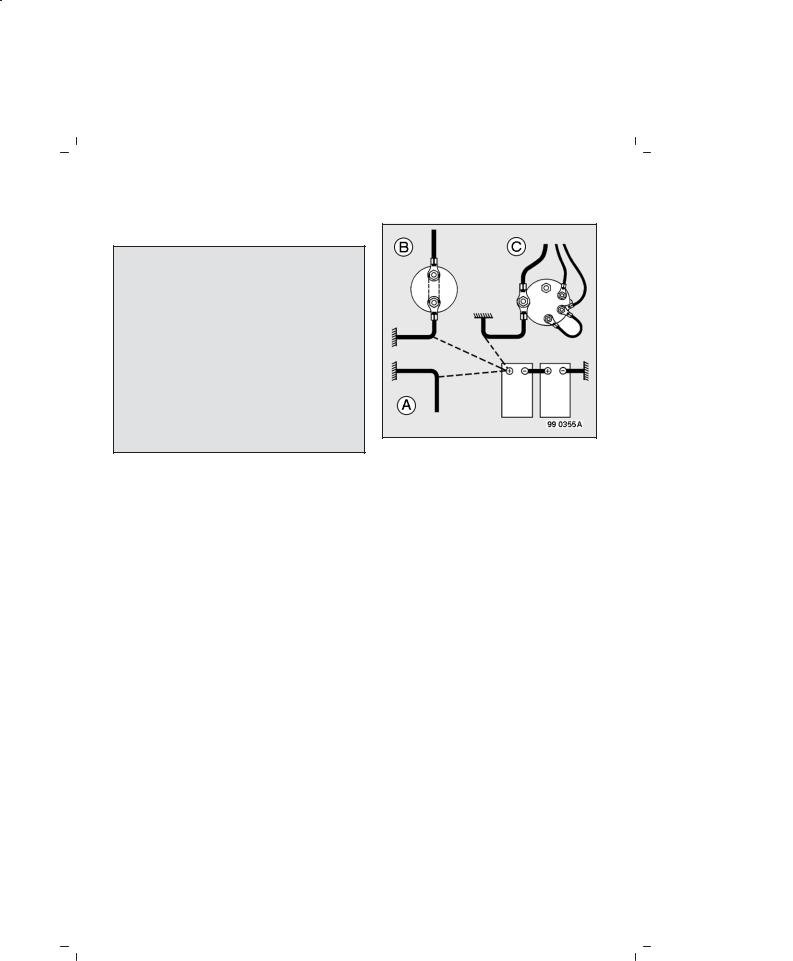
B4 specifications
WELDING ON VEHICLE
Important precautions
The vehicle is equipped with numerous electronic circuits.
Prior to carrying out any electric welding work, disconnect the positive (+) cable from the terminals of the battery and connect it to earth.
Place the earthing clamp as close as possible to the weld, but never attach it to a rotating part (prop shaft, hub, fan, etc.), nor to any sub– assembly having moving parts (air compressor, turbocharger, etc.).
Nearby plastic pipes and electrical cables are to be protected or removed. This also applies for grinding or drilling work.
Diagram A: Vehicle without master switch
Diagram B: Vehicle with mechanical master switch
The master switch must be closed.
Diagram C: Vehicle with electrical master switch
Disconnect the two cables and connect them together.
Soundproofing screen(s)
Any damage to the interior protective film of the screen requires replacement of the film. See that no flammable products are applied to the screen protective films. The screens are to be cleaned using a cloth. If necessary, use soapy water (any other product is strictly forbidden).
The application of solvent or paint to either inner or outer faces of soundproofing screens is to be prohibited.

B5 specifications
CAPACITIES
Litres
OIL
Engine
– engine dry . . . . . . . . . . . . . . . . . . . . . . . . . . . . . . . . . . 36
– without filter change . . . . . . . . . . . . . . . . . . . . . . . . . . 32
– with filter change . . . . . . . . . . . . . . . . . . . . . . . . . . . . 36
Gearbox ZF 16 S 181 / 221
Normal oil change . . . . . . . . . . . . . . . . . . . . . . . . . . . . . 10 Dry oil sump . . . . . . . . . . . . . . . . . . . . . . . . . . . . . . . . . 13 Power take–off . . . . . . . . . . . . . . . . . . . . . . . . . . . . . . . . . 1
Gearbox ZF 16 S 181 / 221 + INTARDER
Normal oil change . . . . . . . . . . . . . . . . . . . . . . . . . . . . . 18 Dry oil sump . . . . . . . . . . . . . . . . . . . . . . . . . . . . . . . 21.5 Power take–off . . . . . . . . . . . . . . . . . . . . . . . . . . . . . . . . . 1
Gearbox ZF ASTRONIC 16 AS 2601
Normal oil change . . . . . . . . . . . . . . . . . . . . . . . . . . . 10.5 Dry oil sump . . . . . . . . . . . . . . . . . . . . . . . . . . . . . . . . . 12 Power take–off . . . . . . . . . . . . . . . . . . . . . . . . . . . . . . . . . 1
Gearbox ZF ASTRONIC 16 AS 2601 + INTARDER
Normal oil change . . . . . . . . . . . . . . . . . . . . . . . . . . . . . 20 Dry oil sump . . . . . . . . . . . . . . . . . . . . . . . . . . . . . . . . . 23 Power take–off . . . . . . . . . . . . . . . . . . . . . . . . . . . . . . . . . 1
Rear drive axle P 1345
Pan . . . . . . . . . . . . . . . . . . . . . . . . . . . . . . . . . . . . . . . . . 15
Hub reduction units . . . . . . . . . . . . . . . . . . . . . . . . |
2 x 0.8 |
Rear drive axle P 1370
Pan . . . . . . . . . . . . . . . . . . . . . . . . . . . . . . . . . . . . . . . . . 15 Wheel hub . . . . . . . . . . . . . . . . . . . . . . . . . . . . . . . 2 x 0.5
Rear drive axle PMR 2141
Middle with adaptation . . . . . . . . . . . . . . . . . . . . . . . . . 18 Rear . . . . . . . . . . . . . . . . . . . . . . . . . . . . . . . . . . . . . . 14.5
Hub reduction units . . . . . . . . . . . . . . . . . . . . . . . . |
4 x 0.8 |

B6 specifications
CAPACITIES |
|
|
Litres |
OIL |
|
Suspension swivels . . . . . . . . . . . . . . . . . . . . . . . . |
2 x 0.9 |
Lift–up axle ER 8
Wheel hub . . . . . . . . . . . . . . . . . . . . . . . . . . . . . . . 2 x 0.7
Lift–up axle ER 11
Wheel hub . . . . . . . . . . . . . . . . . . . . . . . . . . . . . . . 2 x 0.6
Power steering hydraulic system . . . . . . . . . . . . . . . . . 4.5 Clutch hydraulic system . . . . . . . . . . . . . . . . . . . . . . . . 0.5 Cab tilt mechanism hydraulic system . . . . . . . . . . . . . 1.5
COOLANT
Cooling system . . . . . . . . . . . . . . . . . . . . . . . . . . . . . . . . 42
Cooling system + ZF Intarder retarder . . . . . . . . . . . . . |
54 |
WATER
Windscreen washer reservoir . . . . . . . . . . . . . . . . . . . . . 26
FUEL
Depending on your vehicle’s equipment
Fuel tank . . . . . . . . . . . . . . . . . . . . . . . . . . . . . . . . . . . . 410 420 555 595 735
Extra fuel tank . . . . . . . . . . . . . . . . . . . . . . . . . . . . . . . |
275 |
|
410 |
|
420 |
|
555 |
|
595 |
Depending on your vehicle’s equipment
Independent heating system tank . . . . . . . . . . . . . . . . 18.5
KEYS:
Make a note of your key numbers here:
–Ignition key:
–Door key:
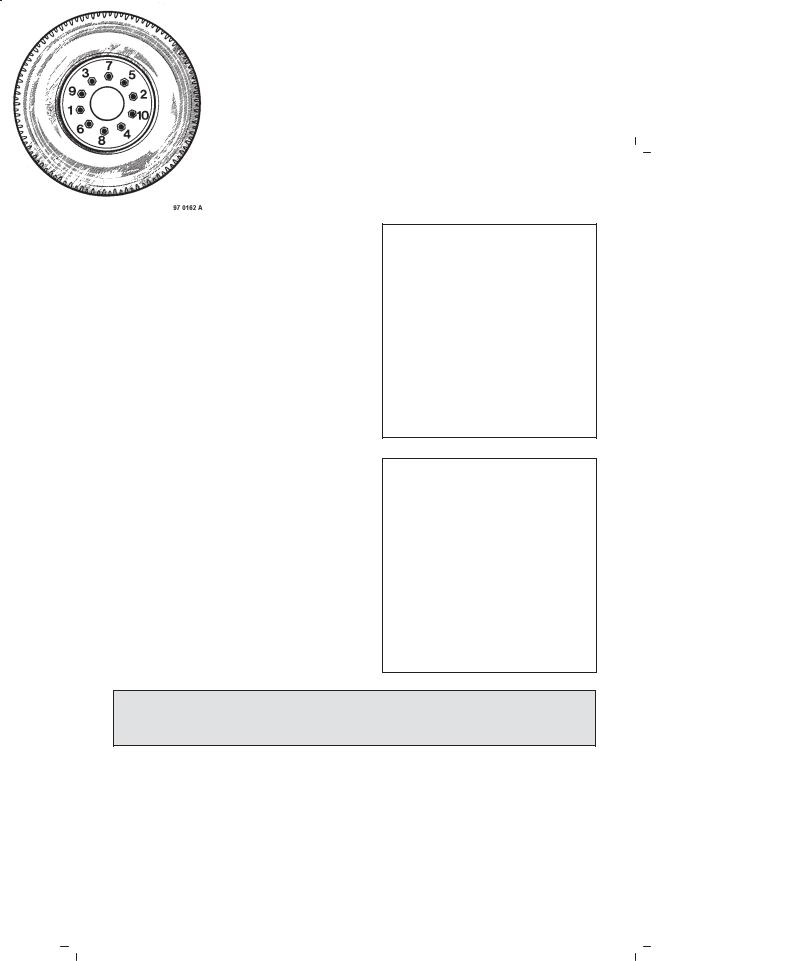
B7 specifications
TYRES
1 – Tyre type
2 – “Tubeless”
3– Load index: single fitment
4– Load index: twin fitment
5– Symbol indicating maximum speed authorized for tyre
Tyre pressures
NOTE
These pressures are given for guidance. Consult the manufacturer’s data concerning specific type and usage information. Respect the load/speed indices marked on the sidewalls of the tyres.
Tightening sequence
– Disc wheels
Steel wheels
Wheel nuts tightening torque 450 → 550 N.m
Light alloy wheels
Tightening torque of wheel nuts 450 → 550 N.m
IMPORTANT
For any modification to tyre type. you must redefine the braking system parameters without fail. Contact your dealer or nearest approved agent.
Depending on your vehicle’s equipment
Tyre type: fitting at front only
|
Load in kg as per fitment |
|
|
Tyre type |
Single |
Twin |
Pressure in Bars |
385/65 R 22.5 |
6 500 |
|
6.5 |
7 000 |
|
7.0 |
|
|
7 500 |
|
7.5 |
|
8 000 |
|
8.0 |

B8 specifications
Depending on your vehicle’s equipment |
|
|
|
|
Load in kg as per fitment |
|
|
Tyre type |
Single |
Twin |
Pressure in Bars |
|
5 330 |
9 800 |
7.0 |
295/60 R 22.5 |
5 680 |
10 420 |
7.5 |
6 020 |
11 050 |
8.0 |
|
|
6 360 |
11 680 |
8.5 |
|
6 700 |
12 300 |
9.0 |
305/60 R 22.5 |
5 900 |
11 500 |
8.0 |
6 300 |
11 900 |
8.5 |
|
|
6 700 |
12 300 |
9.0 |
|
5 560 |
10 550 |
7.0 |
315/60 R 22.5 |
6 030 |
11 240 |
7.5 |
6 390 |
11 920 |
8.0 |
|
|
6 760 |
12 600 |
8.5 |
|
7 100 |
|
9.0 |
|
5 660 |
10 555 |
7.0 |
305/70 R 22.5 |
6 030 |
11 240 |
7.5 |
6 395 |
11 920 |
8.0 |
|
|
6 760 |
12 600 |
8.5 |
|
7 100 |
|
9.0 |
|
6 700 |
12 300 |
8.5** |
|
5 980 |
11 225 |
7.0 |
315/70 R 22.5 |
6 370 |
11 955 |
7.5 |
6 755 |
12 675 |
8.0 |
|
|
7 140 |
13 400 |
8.5 |
|
7 500 |
|
9.0 |
|
7 100 |
12 600 |
8.5** |
|
5 560 |
9 880 |
6.5 |
295/80 R 22.5 |
5 950 |
10 560 |
7.0 |
6 330 |
11 240 |
7.5 |
|
|
6 720 |
11 920 |
8.0 |
|
7 100 |
12 600 |
8.5 |
|
6 270 |
11 090 |
6.5 |
315/80 R 22.5 |
6 700 |
11 860 |
7.0 |
7 140 |
12 640 |
7.5 |
|
|
7 570 |
13 400 |
8.0 |
|
8 000 |
|
8.5 |
|
7 500 |
13 400 |
8.0** |
12 R 22.5 |
5 560 |
9 880 |
6.5 |
5 950 |
10 560 |
7.0 |
|
|
6 330 |
11 240 |
7.5 |
|
6 720 |
11 920 |
8.0 |
|
7 100 |
12 600 |
8.5 |
|
5 790 |
10 340 |
6.0 |
|
6 210 |
11 100 |
6.5 |
13 R 22.5 |
6 640 |
11 870 |
7.0 |
7 070 |
12 630 |
7.5 |
|
|
7 500 |
13 400 |
8.0 |
|
8 000 |
13 400 |
8.0** |
**: according to load index and speed symbol.

B9 specifications
Depending on your vehicle’s equipment
VEHICLE IDENTIFICATION
1 – Chassis
2 – Drive axle
3 – Tachograph plate
4 – Gearbox
5 – Engine
6 – Axle
7 – CAM reference
8 – Paint reference
9 – Manufacturer’s production number
10 – Manufacturer’s identity plate
11 – Conformity plate

C1 use of the vehicle
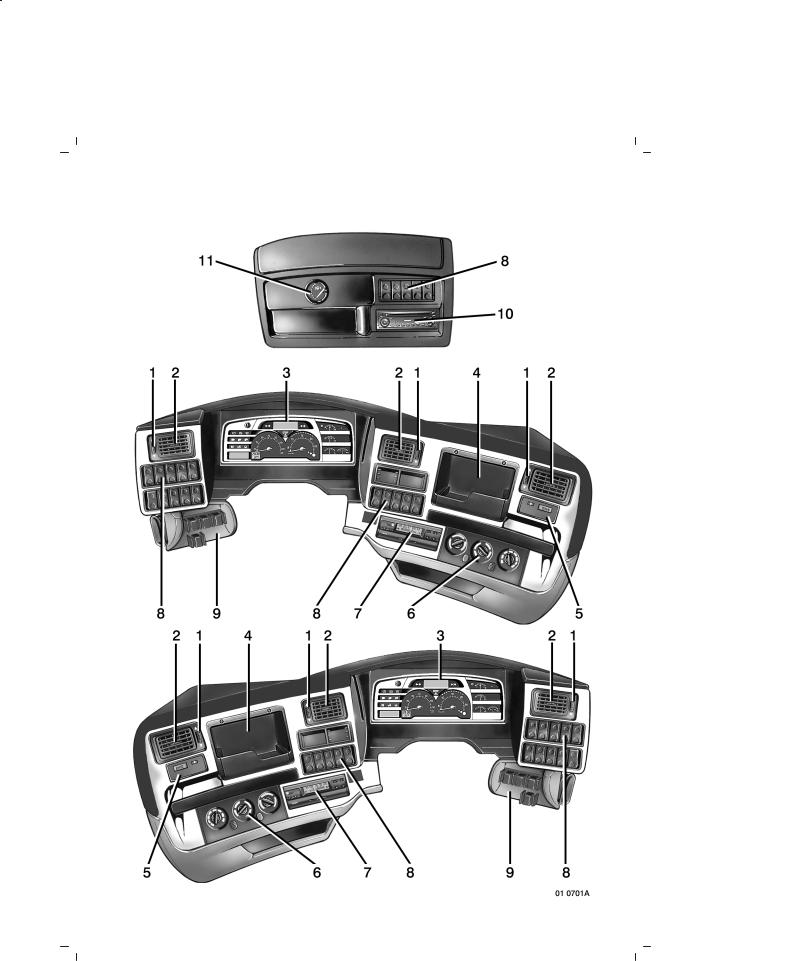
C2 use of the vehicle

C3 use of the vehicle
DASHBOARD
Depending on your vehicle’s equipment
1– Air vent(s) control
2– Air vent
3– Display
4– Driver’s map pocket
5– Clock
6– Climate control panel
7– Tachograph
8– Switches (see page C12 / C13)
9– Control cluster (see page C14) 10 – Space for radio
11 – Brakes air pressure gauge
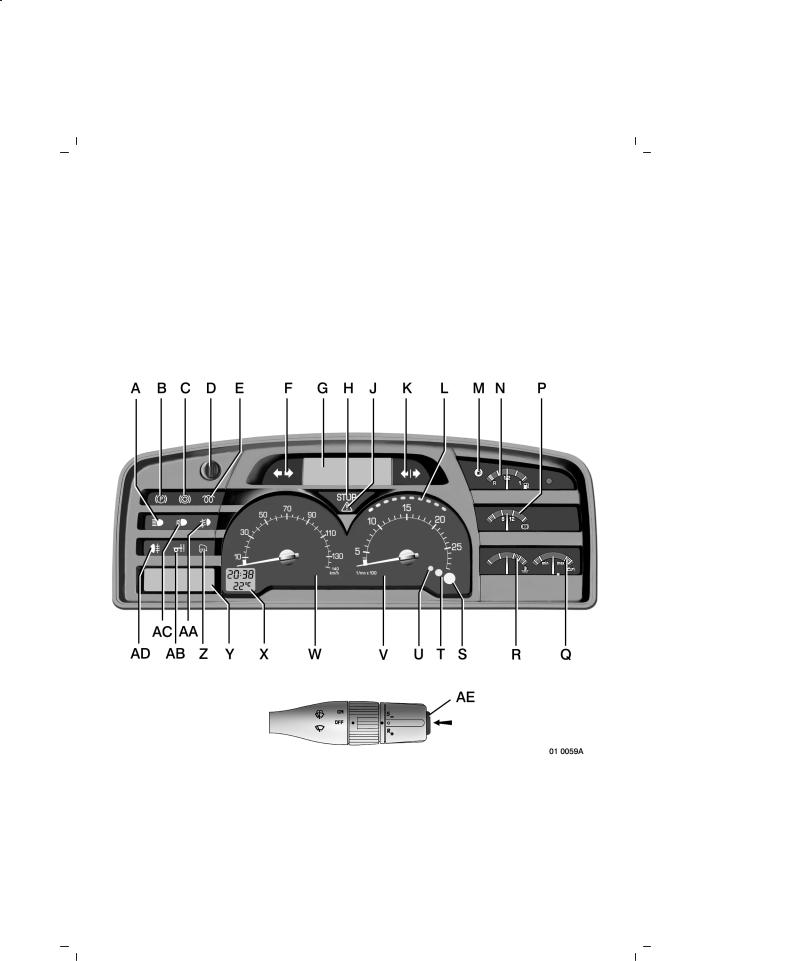
C4 use of the vehicle

C5 use of the vehicle
DASHBOARD
A– Main beam headlights warning light
B– Parking brake warning light
C– Electric retarder warning light
D– Menu selection control
E– Preheating warning light
F– Tractor direction indicator lights warning light G – Multi–function display (see page C15 → C30)
H – “DANGER” warning light: immediate stop
J – “SERVICE” warning light: drive to your dealer or nearest approved agent K – Trailer direction indicators warning light
L– Engine operating speed zone
M – Fuel minimum reserve warning light N – Fuel level gauge
P– Air pressure gauge
Q – Engine oil level and pressure gauge
R– Engine cooling system temperature gauge
S– Engine overspeed warning light
T– Engine brake in operation warning light
U– Engine–brake pre–selection and in operation warning light
V– Rev counter
W – Speedometer
X– Comfort display:
. clock
. external temperature indicator
Y |
– Radio display |
Z |
– Windscreen defrosting warning light |
AA |
– Fog driving lights warning light |
AB |
– Electronic air suspension “Information” warning light |
|
– Axle load shedding “Information” warning light |
AC |
– Dipped beam headlights warning light |
AD |
– Rear fog lights warning light |
AE |
– Driving information selection button |

C6 use of the vehicle
MULTI–FUNCTION DISPLAY
Key to illuminated warning pictograms
Depending on your vehicle’s equipment
G1 – Display defect
G2 – Batteries:
. small pictogram: complementary information
. large pictogram: charging defect
G3 – Engine oil pressure
G4 – Vehicle electronics
G5 – Engine electronics
G6 – Minimum air pressure “Alert”
– EBS defect
G7 – Trailer “ABS/EBS”:
. small pictogram: check–out of device upon ignition switch–on (no defect)
. large pictogram: device defect “alert”
G8 – Tractor “ABS/EBS”:
. small pictogram: check–out of device upon ignition switch–on (no defect)
. large pictogram: device defect “alert”
G9 – Maintenance alert
G10 – Brake pads wear
G11 – Servo steering oil insufficient level or pressure defect

C7 use of the vehicle
Key to illuminated warning pictograms
Depending on your vehicle’s equipment
G12 – Electronic air suspension “Alert”
G13 – Engine cooling system temperature “Alert”
G14 – Engine coolant low level
G15 – Air filter clogging and/or fuel filter clogging
G16 – Tachograph defect
G17 – Gearbox defect
G18 – Electronic anti–theft defect
G19 – Engine overspeed
G20 – Engine downrated (fall–back mode)
G21 – Retarder defect
G22 – Cruise control activated
G23 – AIRBAG
. small pictogram: check–out of device upon ignition switch–on (no defect)
. large pictogram: device defect “alert”

C8 use of the vehicle
Key to illuminated warning pictograms
Depending on your vehicle’s equipment
G24 |
– Gearbox PTO in operation |
G24 |
– Gearbox PTO in operation |
G24 |
– Gearbox PTO in operation |
G24 |
– Gearbox PTO in operation |
G25 |
– Inter–wheel diff. lock in operation |
G25 |
– Inter–wheel diff. lock in operation |
G25 |
– Inter–wheel diff. lock in operation |
G25 |
– Inter–wheel diff. lock in operation |
G26 – Inter–axle diff. lock in operation |
|
G27 |
– Wheel slip or “ASR” in operation |

C9 use of the vehicle
Key to illuminated warning pictograms
Depending on your vehicle’s equipment
G28 – “ASR” threshold change
G29 – Self–tracking axle lock in operation
G30 – Working spotlight
G31 – Tailgate in dangerous position
G32 – Tipper raised “Information”
G33 – Special machine (tanker handrail) deployed
G34 – Sideboard open
G35 – Crane / tower platform deployed
G36 – Message received (fleet management)
G37 – Centralized lubrication in operation
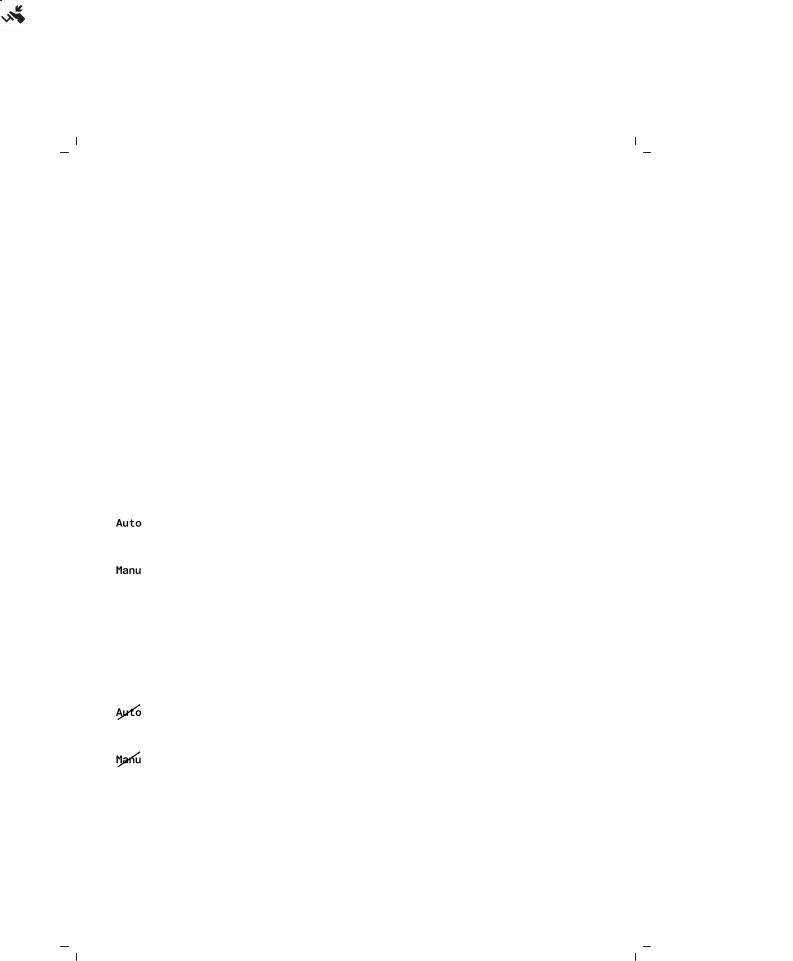
C10 use of the vehicle
Key to gearbox warning pictograms
Depending on your vehicle’s equipment
G38 – ASTRONIC selector moved to (D)
G39 – ASTRONIC selector moved to (N)
G40 – ASTRONIC accelerator pedal released
G41 – ASTRONIC test
G42 – “ASTRONIC” gearbox defect
G43 – OPTIDRIVER: “integral automatic mode”
G44 – OPTIDRIVER: “permanent or temporary manual mode”
G45 – OPTIDRIVER: “maximum vehicle mobility”
G46 – OPTIDRIVER: “use brakes or retarders”
G47 – OPTIDRIVER: “automatic mode unavailable”
G48 – OPTIDRIVER: “manual mode unavailable”

C11 use of the vehicle
Key to tachograph tell–tale pictograms
Depending on your vehicle’s equipment
G49 – Cumulated driving time indication
G50 – Cumulated rest time indication
G51 – Rest in progress indication
G52 – Availability time indication
G53 – Working time indication
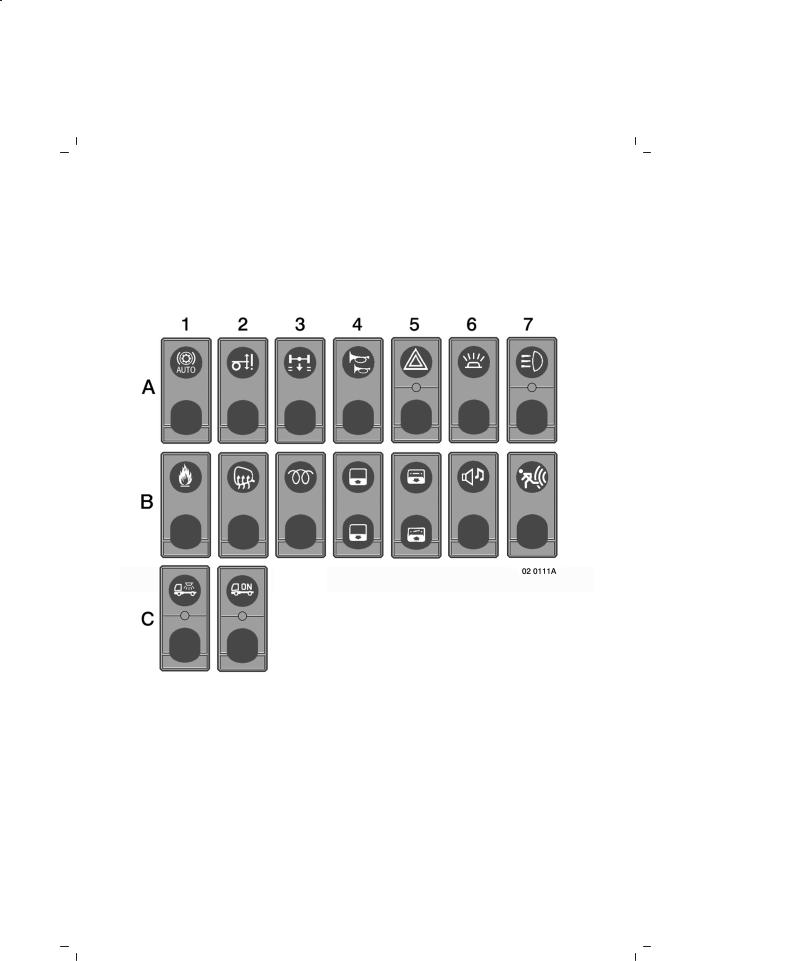
C12 use of the vehicle

C13 use of the vehicle
KEY TO SWITCHES
Depending on your vehicle’s equipment
A1 – Retarder control (manual / automatic)
A2 – Axle load shedding switch
A3 – “ASR” switch
A4 – Horns selection switch
A5 – Hazard lights control
A5 – Hazard lights warning light
A6 – Roof light switch
A7 – Long beam driving lights switch
A7 – Long beam driving lights warning light
B1 – Independent heating switch
B2 – Rearview mirrors and heated windscreen switch
B3 – Engine preheat switch
B4 – Front sun visor control
B5 – Sun–roof switch
B6 – Cab rear radio power switch
B7 – “Panic” alarm button
C1 – Bodybuilder’s lighting switch
C1 – Bodybuilder’s lighting warning light
C2 – Bodybuilder’s equipment control
C2 – Bodybuilder’s equipment warning light
